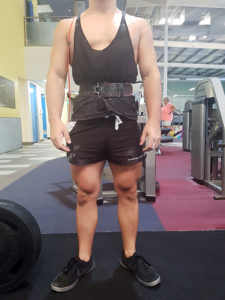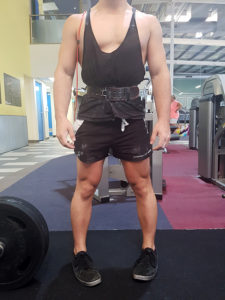Understanding Hip Rotation
What is external and internal hip rotation?
You've probably heard that your glutes (aka ass) are important muscles. They directly influence hip rotation & position and when activated correctly they can help your body move in an ideal way for specific tasks.
The glutes are one of the muscle groups responsible for external (outward) rotation of the hip. External rotation is important because it increases torque in the joint. When you add this rotation it removes the slack within the joint making it very tight and stable.
It is important to note that when increasing torque via external rotation as demonstrated in the picture above, you DO NOT have to turn your feet outwards.
In fact most of the time it is ideal to have your feet facing forwards. To increase torque you must attempt to force the hip into external rotation while the foot is planted on a fixed surface, thus taking up the slack in the joint.
Why is internal rotation so common?
If you're observant enough when at the gym or watching people play sport you'll notice that despite the benefits of external rotation many people still fall into internal (inward) rotation during certain movements.
There are a number of reasons why this might happen.
One reason is that many people are unaware they are doing it. How are you able to correct something if you don't know you're doing it in the first place.
Poor motor control is another reason. What this means is that even if people are aware they are doing it they don't know how to control the movements in order to prevent it. There are a number of exercises and coaching techniques that can address this. It is best to work alongside a health professional such as a physiotherapist to address this.
Weakness is also very common in these individuals. As mentioned the muscles responsible for external rotation are your gluteal (ass) muscles. If these are not strong enough they won't be able to hold the hip where it is supposed to be. The obvious fix here is to strengthen your butt!
Last but not least we have flexibility. If the muscles surrounding the hip aren't flexible enough the body may adapt to move within the range it has available. To address this you will want to work on hip joint mobility and stretching of related muscles which include the hip flexors, hamstrings, quadriceps, adductors (groin) and glutes.
Why should we care?
Do you get pain in your back, hips, knees, ankles or feet? There is a chance that this pain could be generated from poor movement patterns involving internal rotation of the hip.
Do you want to be stronger? If you're someone who's hips fall into internal rotation during movements such as squats, running or jumping then you're losing a lot of potential power!
To reiterate again, increasing torque via external rotation will positively affect stability of the hip, knee and foot. Increasing stability/torque allows for greater force production.
At the knee this increased stability helps to prevent uneven loading and will decrease the laxity in the ACL thus reduces risk of ACL tear when performing high impact movements. Other injuries which can occur from decreased stability include patella tendinopathy and patellofemoral pain.
At the ankle/foot position external rotation helps to increase ankle range of motion, it reduces the risk of ankle injury from high impact and repetitive ankle movements. Injuries that can occur here include (but not limited to): anterior ankle impingement, development of bone spurs, Achilles tendinopathy.
So why should we care? Because increasing torque in the hip by creating external rotation or 'activating your glutes' for movement patterns decreases risk of injury and can produce an increase in strength.
Hopefully this helps you to understand why it is important for us to have good gluteal strength and activation. When in doubt you can't go wrong getting strong!
About the Video
The video above demonstrates the differences in knee, ankle and foot position when the hip is either externally rotated or internally rotated.
As you can see when the hip is externally rotated it increases the torque and helps stabilise the lower leg. The most obvious change you'll notice is the difference in height of the arch around the mid foot. These changes are important for functional movement. Squats, running and jumping are good examples.
Other changes in position can also be seen at the hips, knees and ankles.
This video is demonstrated on two individuals through three different shots.
Shot 1: Demonstrates a front on view of internal and external rotation
From a front on view we are able to see the knees collapse in during internal rotation we call this a valgus force which creates a very uneven weight distribution through the kness
Shot 2: Demonstrates a side view of internal and external rotation on the left leg
In this angle the effect that internal rotation has on the foot is very clear. You can see the medial arch of the foot collapse during internal rotation and being picked up during external rotation.
Shot 3: Demonstrates the difference in squat movement first when internal rotation is performed then external.
When the hips fall into internal rotation during the squat it jams up the hips and the ankles not allowing for full range of motion. It also increases forces to the inside of the knee. Squatting like this over time increases risk of injury and also creates a number of 'energy leaks' through the movement which effectively decreases the amount of strength you can recruit to complete the movement.
Need to see a Physio in North Brisbane? We have two locations on the Northside including North Lakes and Brendale. Book online or call to book.

